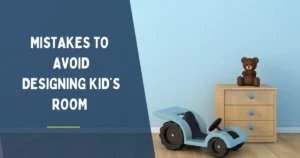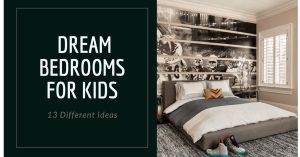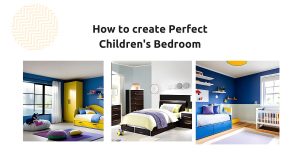As a parent, one of the most important purchases you’ll make is your child’s bed. The right bed can help your child sleep better, be more comfortable, and suit their needs as they grow. With so many options on the market, choosing the perfect kids’ bed can be challenging. This Buying guide covers the pros and cons of the most popular 13 types of beds for Kids to help you make the best decision for your family.
We’ll cover key factors like safety, quality, and your child’s needs at different ages so you can confidently select the perfect bed for your son or daughter. Whether you need a bed for a toddler, a bigger kid, or a tween, you’ll find detailed information about sizes, features, pros and cons, and top brands for bunk beds, loft beds, canopy beds, cabin beds, twin beds, and so on. We have also shared some dream bedroom Ideas for your kids this will help you to choose right bed and bedroom together.
01. Toddler Beds
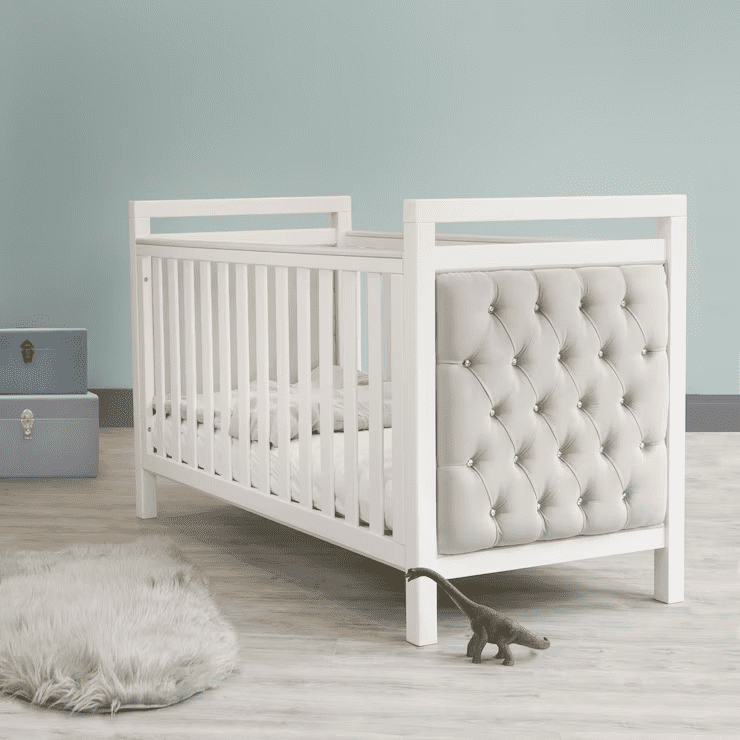
Imagine a bed that’s just right for your growing child: not too big and not too small. That’s where toddler beds come in. These beds are like a springboard between a crib and a “big kid” bed. When your little one outgrows the crib but isn’t quite ready for a bigger bed, toddler beds offer a cozy and safe option.
One of the best things about toddler beds is that they are designed with safety in mind. Like cribs, they come with features that help prevent accidental falls. This gives you peace of mind as your child transitions to a new way of sleeping.
But here comes the interesting thing: Children’s beds also give your child a feeling of independence. They are lower to the floor, making it easier for your child to get in and out of bed on their own. It is a small step towards growth and can make your child very proud.
Pros:
- Toddler beds prevent dangerous falls like a crib does. The sides are low enough for your toddler to get in and out unassisted, but high enough to keep them from falling out.
- They help toddlers feel “grown up” and facilitate the crib-to-bed transition.
- Many toddler bed frames convert to a daybed or sofa as your child gets older.
Cons:
- Your child may attempt to climb out, requiring you to lower the mattress or install a bed rail.
- Toddlers may miss the cozy, enclosed feeling of a crib at first.
Best For: Toddlers aged 18 months to 3 years
02. Loft Beds
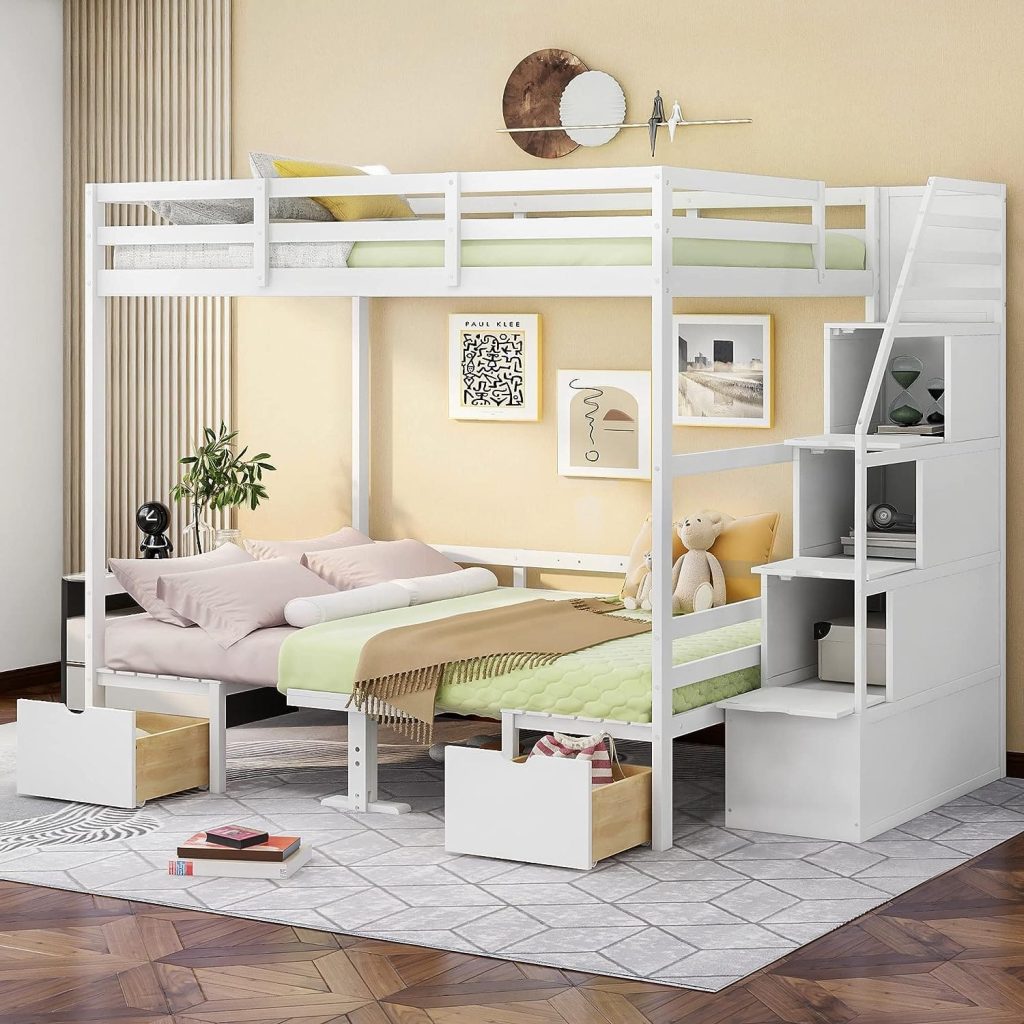
Loft beds typically feature a sleeper on the top bunk with space underneath available for multiple uses. They are perfect for children’s bedroom designs where you want to combine the bed with another piece of furniture, such as a desk or additional storage unit, in the same space.
Loft beds elevate a standard twin or full mattress on an upper frame or platform to create space underneath for work, lounging, or storage. Many include built-in ladders or stairs.
Pros:
- Loft beds free up the floor area underneath the bed for play and activities.
- They provide extra storage for toys, books, and art supplies with shelving under the bed.
- Loft beds feel like having a private space or treehouse for kids.
Cons:
- Children can fall from lofted beds, requiring guardrails.
- Low ceilings may not allow height for a loft.
- Climbing up and down ladders/stairs can be unsafe for younger kids.
Best For: School-age kids who will use the under-bed space responsibly. Loft beds work best in taller rooms.
03. Beds with Slides

Some bunk beds and loft beds incorporate built-in slides, allowing kids to slide down from the top bunk or loft space. These interactive beds turn sleeping into an adventure.
Pros:
- Slides let kids easily and safely descend from the top bunk.
- They add fun and interactive play value to bedtime and wake-up.
- Many styles and slide designs are available to choose from.
Cons:
- Only older, school-aged kids are physically ready for slide beds.
- Slides can be noisy and disruptive in the early morning or nighttime.
- Proper safety rails are essential, as slides may encourage dangerous play.
Best For: Silly, energetic big kids who will appreciate the playful spirit of a slid bed. Strict safety rules will be important.
04. Twin Beds
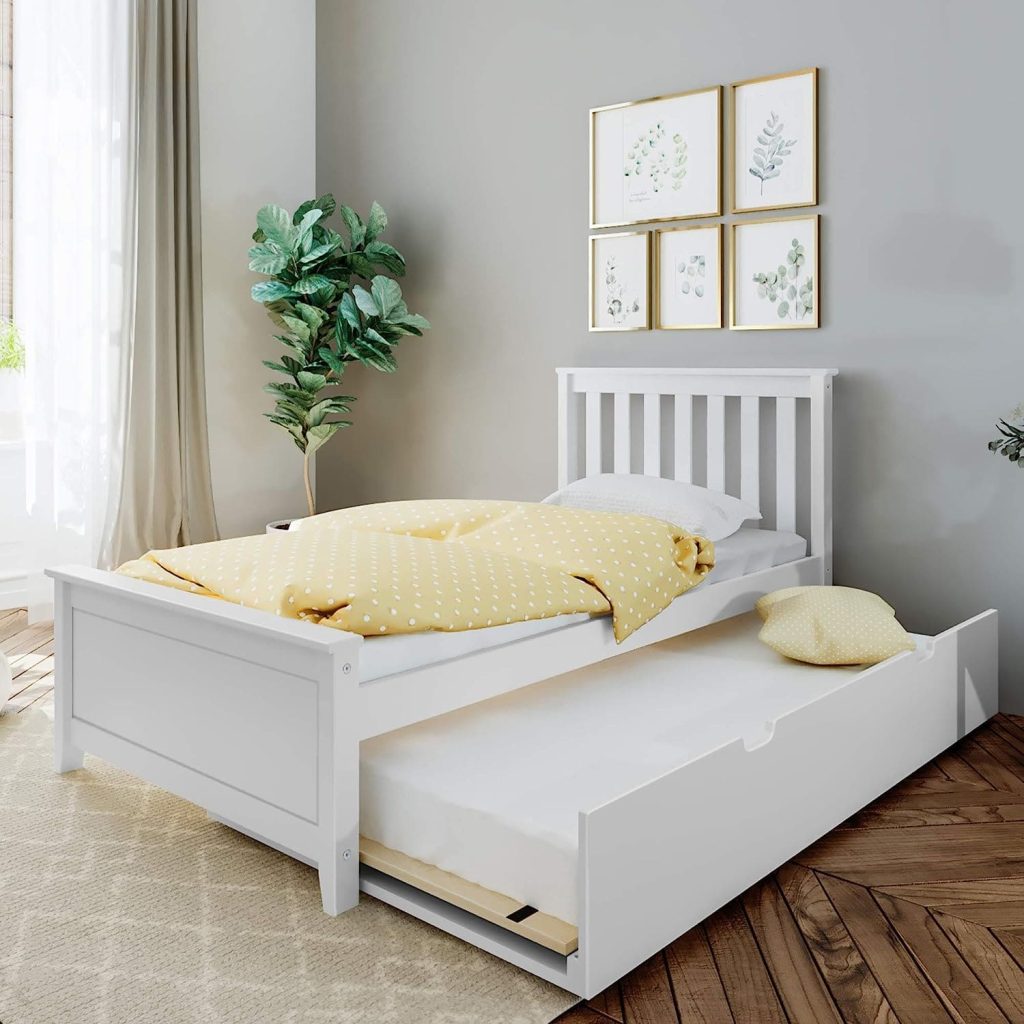
This is another type of Bed for Kids. A twin-sized bed is usually a child’s first “grown-up” bed. Twin beds provide more room to sprawl out than a toddler bed, and come in a wide variety of frame styles.
Pros:
- Twin beds allow room for your child to spread out and sleep in different positions.
- They come in many affordable frame options that grow with your child, from basic metal frames to bunk beds.
- Twin mattresses provide enough support for older children, but the low height prevents dangerous falls.
Cons:
- Your young child may feel overwhelmed by all the space at first.
- They offer limited space for siblings sharing a room or sleepovers.
- Your child will outgrow them at some point and need a larger “big kid” bed.
Best For: Kids aged 3 to 10 years old.
05. Full & Queen Beds
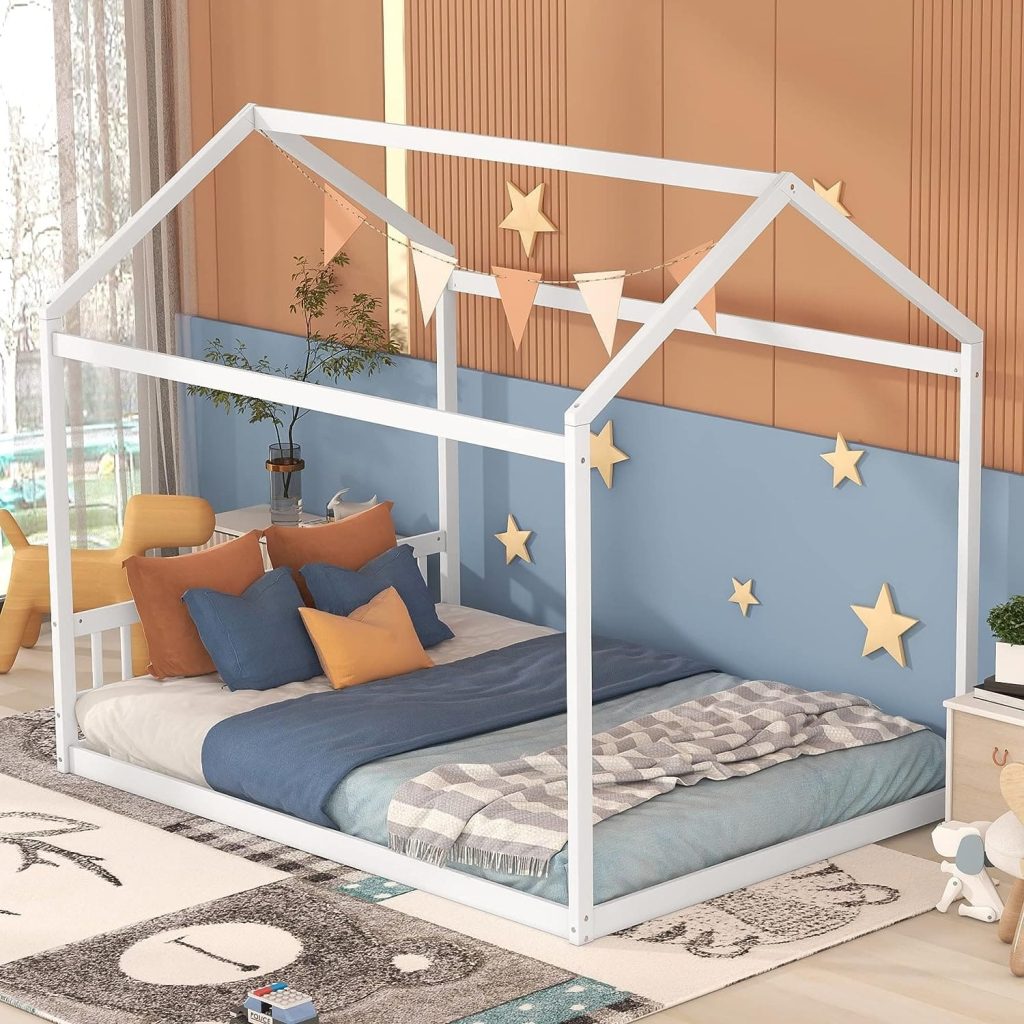
Once your child reaches the “tween” and teenage years, they will likely want to upgrade to a full or queen-sized bed. These provide ample room to sleep and lounge as kids get bigger.
Pros:
- Full and queen beds provide much more generous sleeping space.
- They allow flexibility for sleepovers, reading, or using laptops in bed.
- Your child won’t outgrow a full/queen bed as quickly.
- Many frame styles are available to suit your child’s personality and room decor.
Cons:
- Larger beds take up more space in bedrooms.
- The tall mattress height poses an injury risk for younger kids.
- They are more expensive than twin beds.
Best For: Older children and teenagers.
06. Bunk Beds
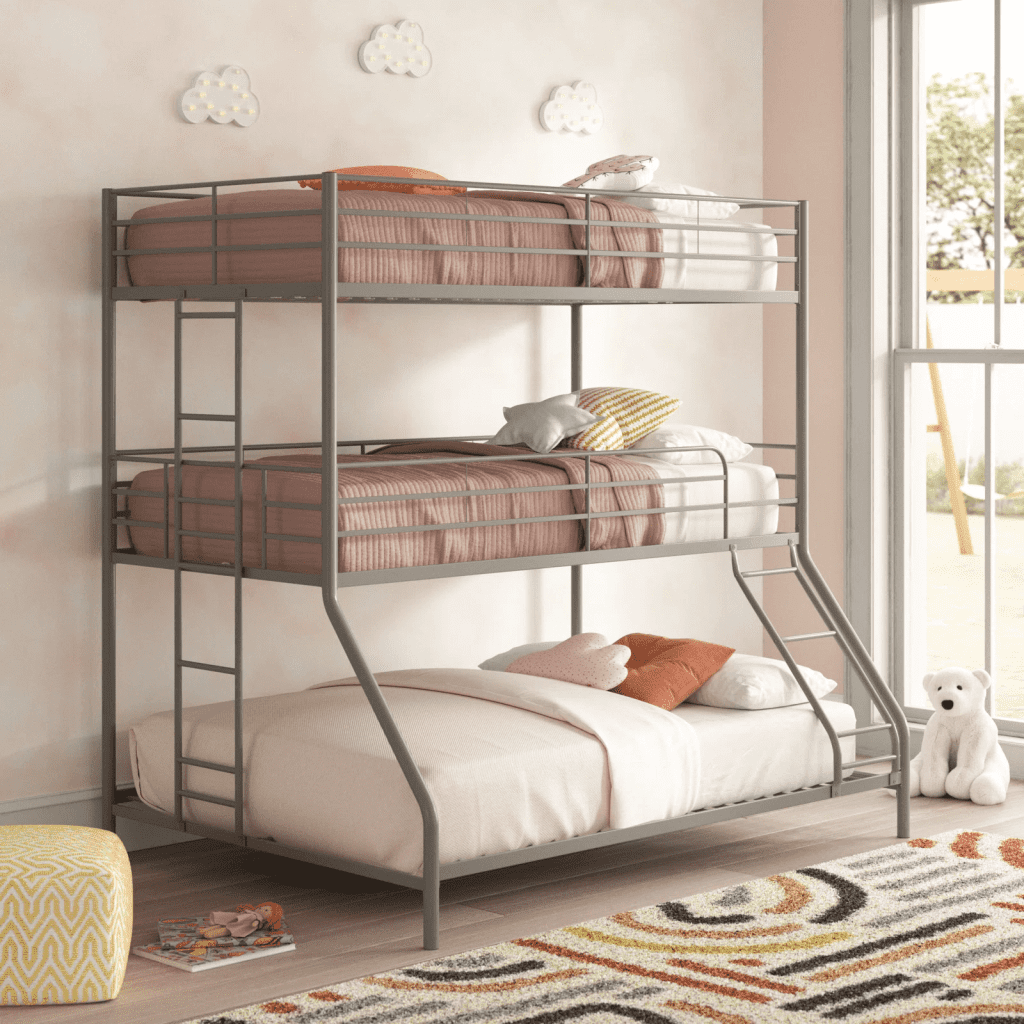
Bunk beds are a space-saving option perfect for siblings sharing a room, sleepovers, and compact bedrooms. Most bunk beds split into two twin beds.
Pros:
- Bunk beds essentially create two beds in a single floor footprint.
- They open up floor space for play or additional furniture.
- Bunk beds add fun, whimsy, and a place for imagination to children’s rooms.
- Many customizable styles, built-in storage, and workspace options exist.
Cons:
- Bunk beds pose fall and injury risks, especially for younger kids on the top bunk.
- Children may fight over who gets the top vs. bottom bunk.
- They may be more expensive than purchasing two twin beds.
Best for: Older children who can safely use a bunk bed. Great for sharing bedrooms.
07. Canopy Beds
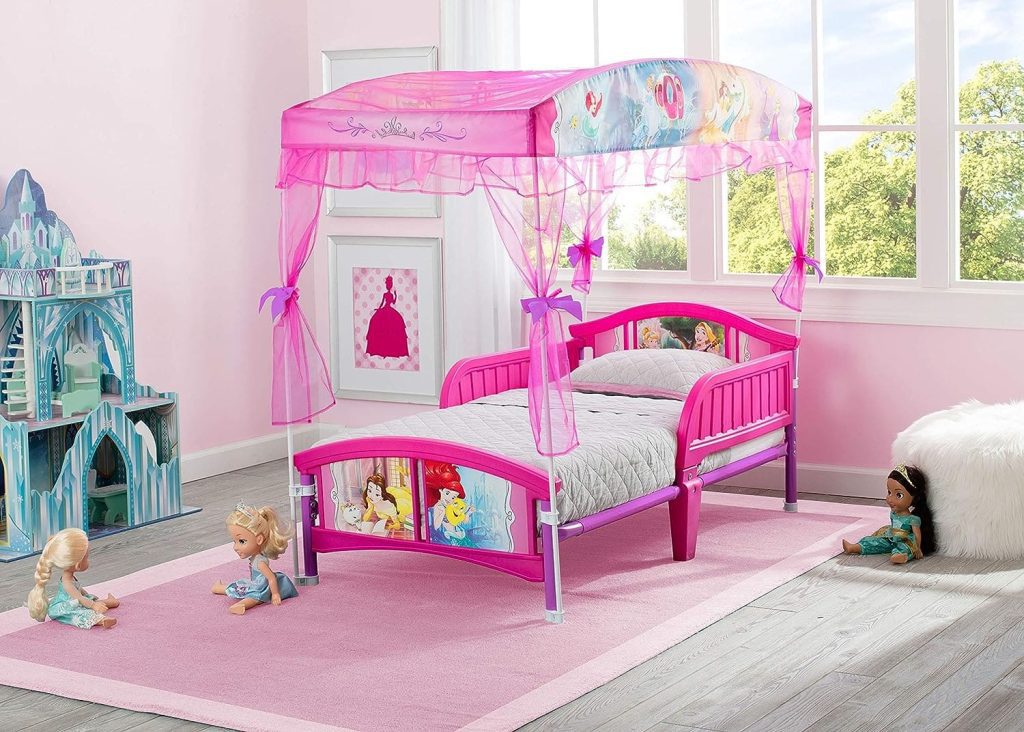
Canopy beds have a decorative fabric top that extends over the bed. The canopy creates a cozy, enclosed space that kids love. Ornate fabric cascading around the bed delights the child’s sense of wonder, an inner forest flanking the mattress. The four-poster beds combine the decorative style with children’s fantasy.
Pros:
- Canopies make beds feel like a play fort or princess castle.
- They create a soothing sleep environment for naps or bedtime.
- Canopy additions can be purchased to add to existing beds later on.
Cons:
- Too much fabric may increase dust and allergens.
- Canopies may need to be removed for safety as kids grow.
- They require slightly more complex bedding.
Best For: Playful, creative kids who will enjoy the canopy space.
08. Trundle Beds
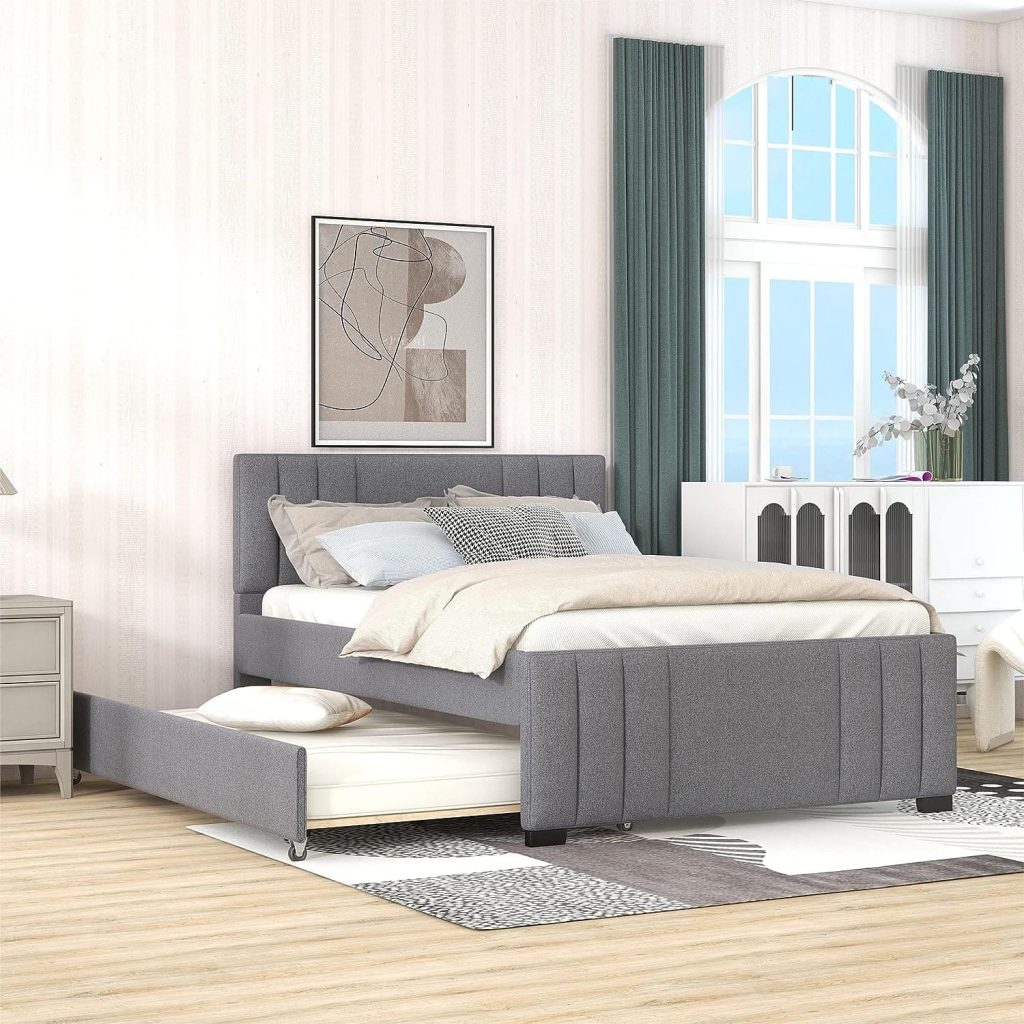
Trundle beds are designed with a second mattress that slides out from its hidden storage spot under the main bed. Mounted on wheels or wheels, the trundle mattress can be gently pulled out when needed to create extra sleeping space, then pushed back under the bed for a clean, space-saving design when not in use. The versatile trundle design conveniently stores an extra guest bed or sleepover bed in your child’s room without taking up permanent floor space.
Pros:
- Trundle beds maximize space with a second bed in one.
- They allow sleepovers or room sharing without buying two full beds.
- Style options range from simple trundles to decorative daybeds.
Cons:
- Trundles need to be made up each time, taking extra effort.
- The lower trundle height can be uncomfortable.
- Opening and closing the trundle makes a noise that may wake some kids.
Best For: Sleepovers, small rooms, having guests visit.
09. Storage Beds
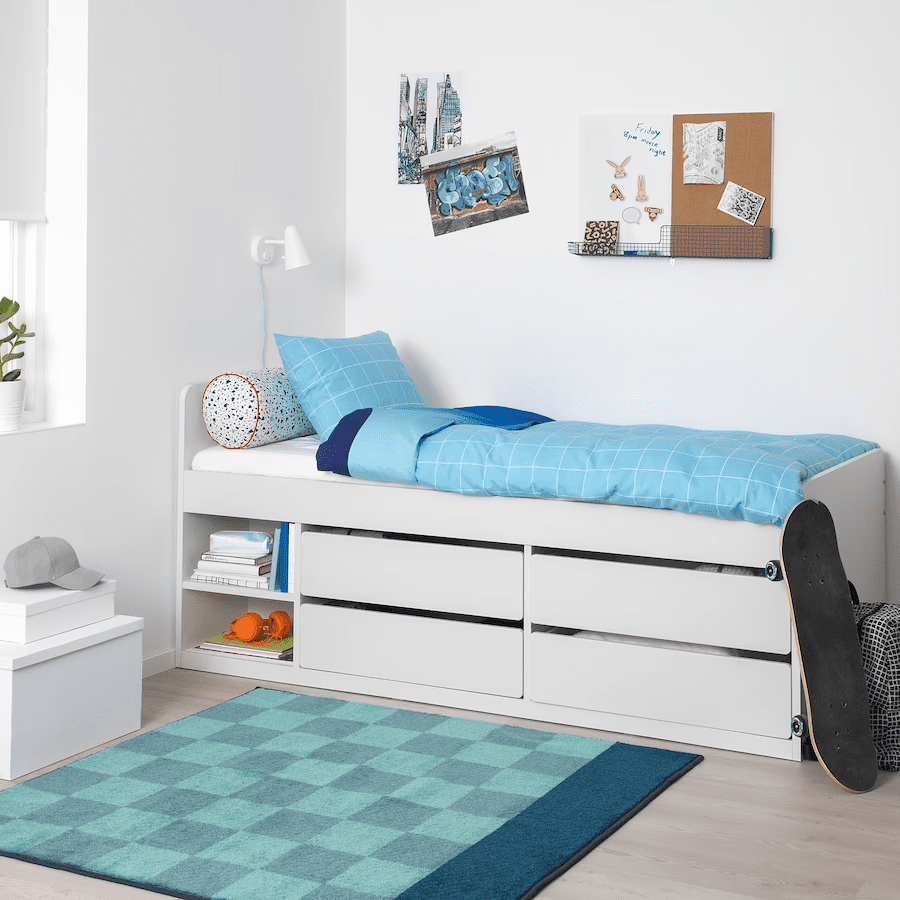
Cleverly designed with storage in mind, Storage Beds maximize space and organization through built-in drawers tucked under the mattress base. These handy drawers allow you to neatly store bedding, pajamas, toys, books and anything else your child wants close at hand while maintaining a tidy bedroom. Discreet pull-out drawers keep essentials organized and within reach without sacrificing floor space to clutter. Beds with storage are an ideal space-saving solution for children who need ample storage space for all their belongings.
Pros:
- Storage beds maximize bedroom space by storing items under the bed.
- Built-in drawers keep items tidy, organized, and dust-free.
- Various drawer configurations and sizes are available.
Cons:
- Storage beds may cost more than basic bed frames.
- Kids may overload drawers, preventing them from closing.
- Accessing storage requires kneeling down which may be difficult.
Best For: Kids with limited closet storage or who need help staying organized. Storage beds prevent clutter.
10. Car Beds
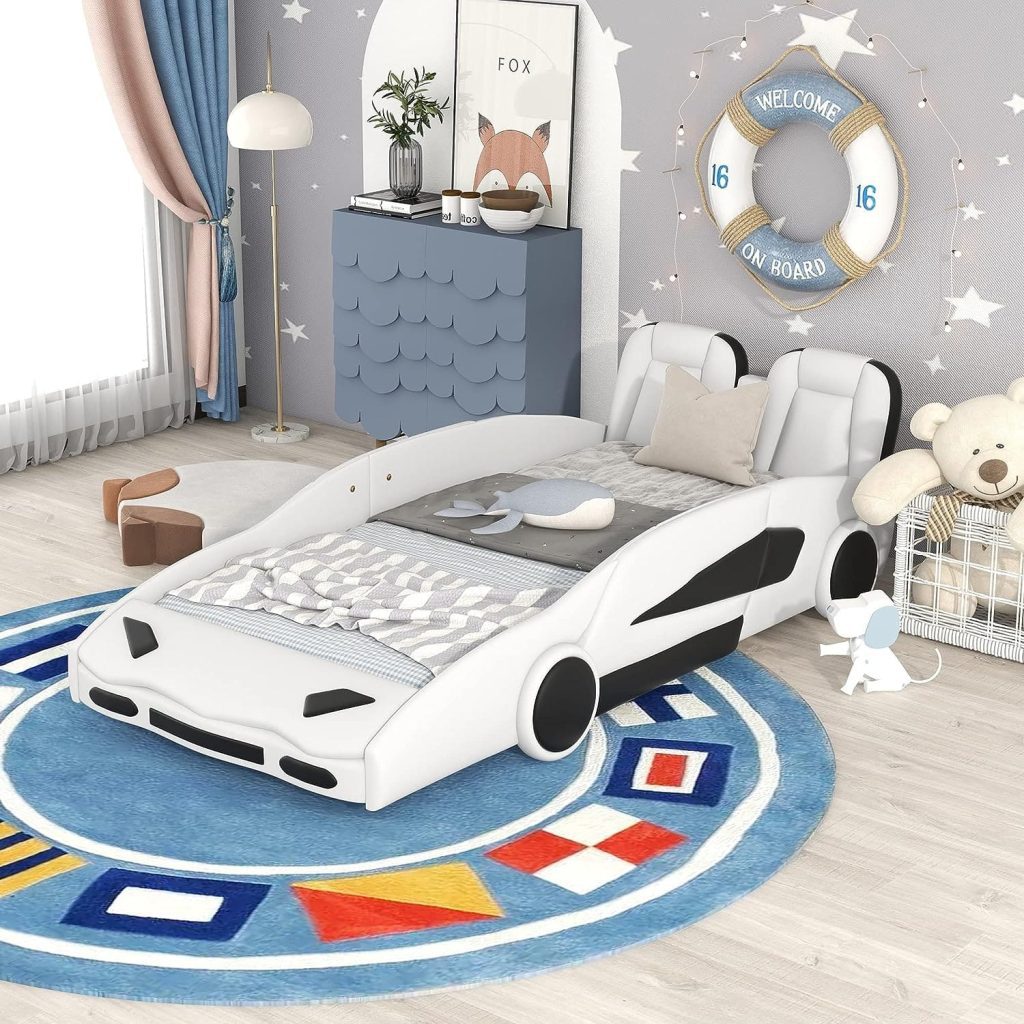
Car beds allow kids to feel like they are sleeping in a racecar, classic car, or other fun vehicle-inspired bed. These are popular novelty beds for car-loving kids.
Pros:
- Car beds appeal to kids who are fascinated with vehicles or racing.
- They make bedtime feel more like an adventure rather than a chore.
- Many customization options exist from sports cars to big rig trucks.
Cons:
- Car beds are often made from cheap materials and may not last.
- The novelty may wear off over time if interests change.
- Actual cars contain toxic materials, while car beds are only mimicking their appearance.
Best For: Car-obsessed kids as a novel, short-term bed. Adults should ensure quality construction for durability.
11. Adjustable Beds
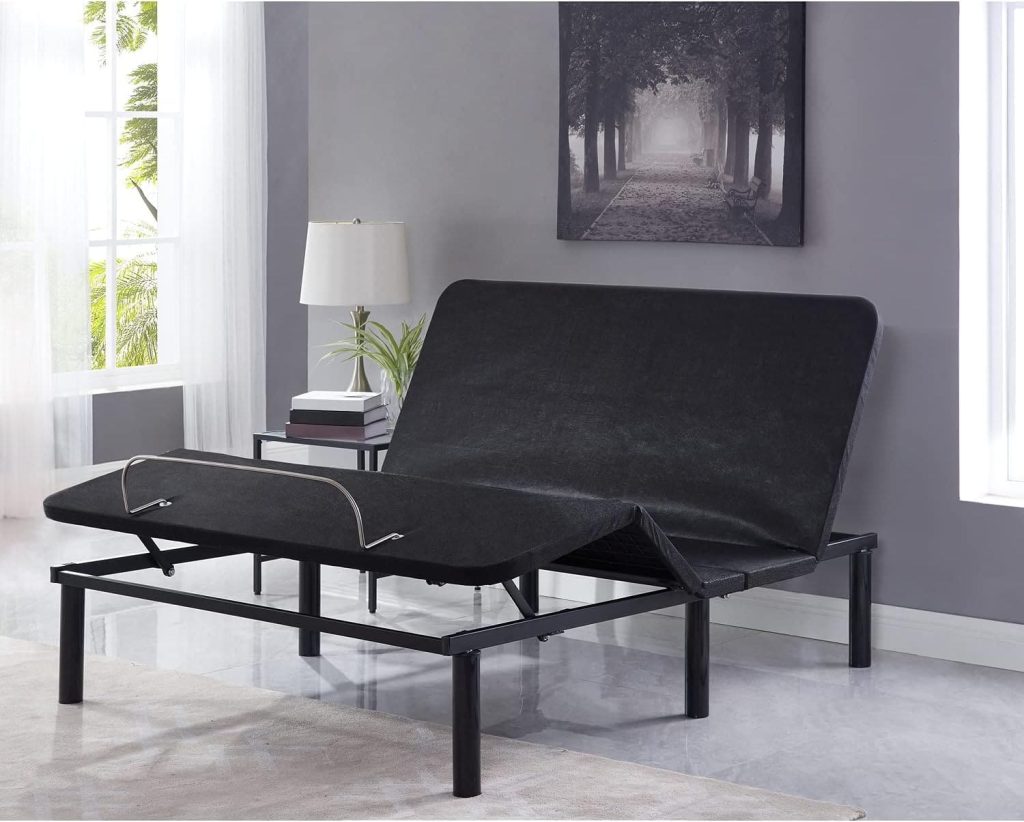
Adjustable beds allow you to raise the head and foot sections. This creates a comfortable reclined position for reading, watching TV, or medical issues.
Pros:
- Adjustable beds are therapeutic for kids with reflux, congestion, or other conditions.
- Raising the bed helps with reading, homework, or gaming in bed.
- Kids feel fun and “grown up” controlling their own bed position.
Cons:
- Adjustable beds are more expensive than basic frames.
- The mechanisms can potentially break down over time.
- Kids may play with the remote excessively or fight over control.
Best For: Kids with special positioning needs or those who enjoy lounging in bed.
12. Captain’s Beds
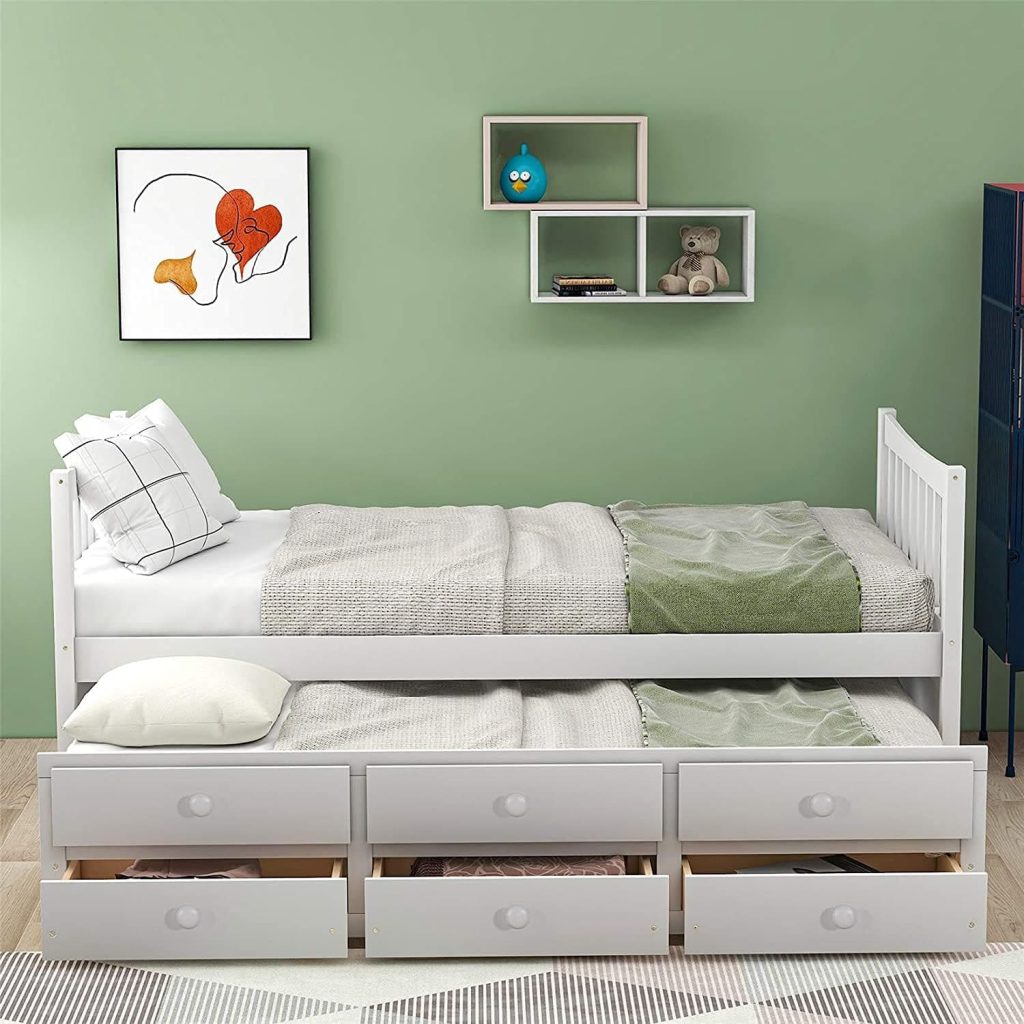
Captain’s beds feature drawers built into the base, providing tons of extra storage. The name comes from their use in ships’ captain quarters.
Pros:
- Captain’s beds maximize storage for clothes, toys, and more.
- Built-in storage helps keep clutter to a minimum.
- Storage drawers are easier to access than under-bed options.
Cons:
- They may cost more than a typical bed frame.
- The fixed drawers reduce space flexibility.
- Kids may fill them excessively, causing clutter again.
Best For: Kids with limited closet space or who need help staying organized.
13. Wall Beds or Murphy Beds
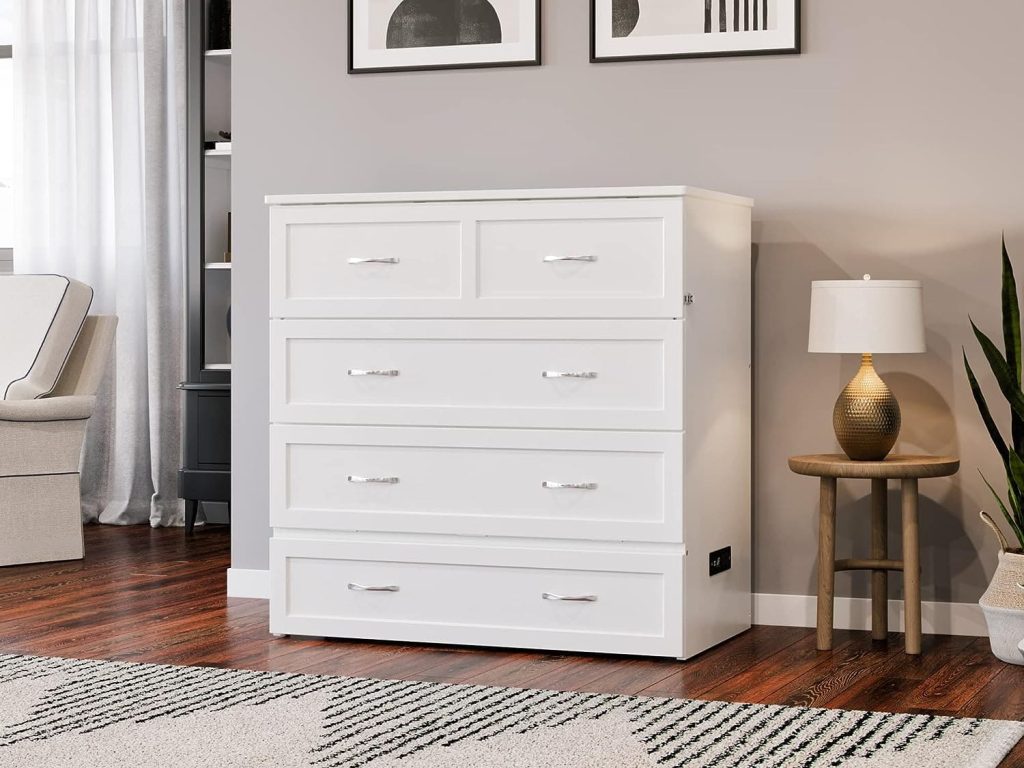
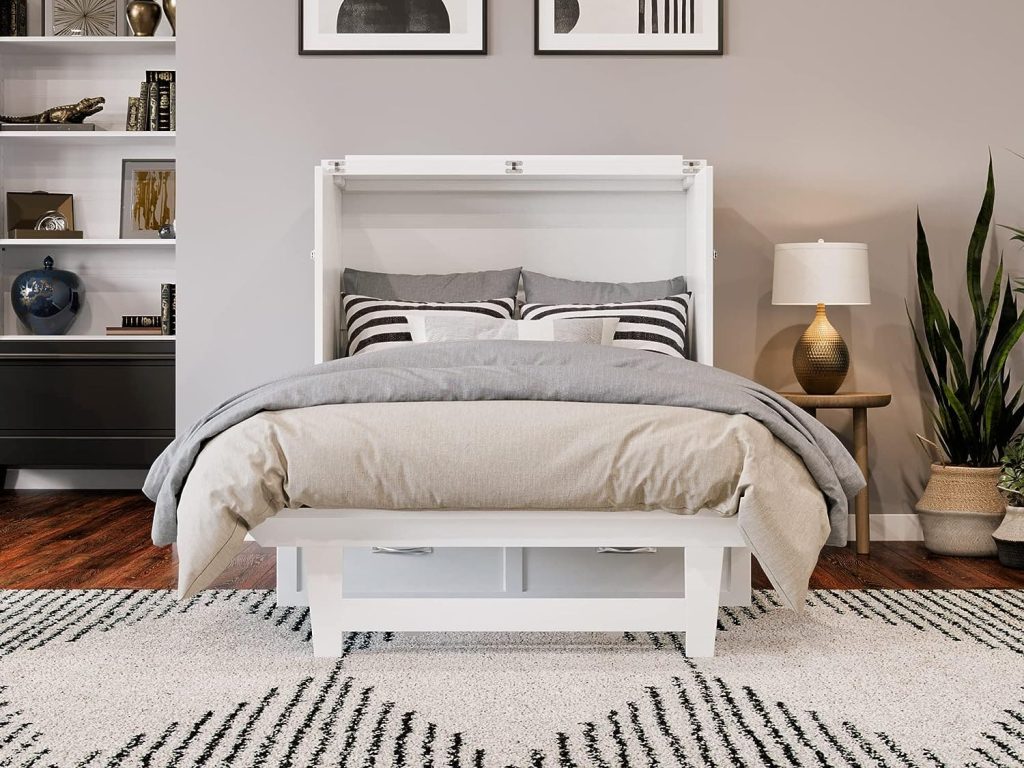
Murphy beds, also known as Murphy beds, are designed to maximize space in small areas. The bed frame folds upright against the wall into a closed position when not in use, leaving open floor space. When required, the bed can simply be lowered into the open, flat sleeping position. Murphy beds are great space-saving options for compact rooms, allowing the area to be converted between a sleeping space and a multipurpose room. Their collapsible versatility makes them a smart choice for children’s rooms with limited square footage.
Pros:
- Wall beds are space-saving for compact bedrooms or maximizing play space.
- They allow the creation a multipurpose room that can convert from a bedroom to a family room.
- Hardware allows beds to easily lift up into an upright storage position.
Cons:
- Wall beds are usually fixed in place and cannot be moved.
- They are more complex to set up initially.
- The folding mechanism may be unsafe for kids if not properly installed.
Best For: Families with small living spaces needing a convertible room. Not ideal for younger kids.
Final Thought
When deciding which bed is best for your child, factor in their age, bedroom sharing needs, maturity level, height, and sleeping habits. Think about how long you want the bed to last as they grow. Safety should also be your top priority. Focus on quality construction and opt for beds with bedrails or guards if needed in order to Create perfect bedroom for your Children. Beyond functionality, choose a frame to match your child’s style and space. With so many options available, you’re sure to find the perfect bed to help your child thrive!


